There are many considerations to weigh when selecting asset labels for your application, from materials to the types of assets you need to track. In this guide, we’ll provide an overview of asset labeling and discuss the key factors to consider to help you select the right asset labels for your company’s needs.
Asset labels, or tags, are used to identify physical items such as equipment, devices, and tools. These labels often include important identifying information about the asset including a serial number, barcode, model number, and product name. A number of different substrate materials may be used to create an asset label depending upon the intended application. Popular label materials include aluminum, vinyl, foil, and polyester.
Most asset labels will have an adhesive on the backside for permanent attachment to a surface or holes for placement on the asset by physical means. In some cases, asset labels may also have a special finish, or coating, on the label surface that can add an additional layer of protection or desired look such as a matte or brushed finish.
Nearly any industry can take advantage of asset labels to track and monitor their equipment, products, or inventory. In combination with software solutions, asset labels can be used with barcode scanners to automate documentation and support a number of processes. For example, using asset labels in conjunction with preventive maintenance software can streamline maintenance management. Companies of nearly any size can benefit from asset management practices and the use of asset labels.
Asset labels are commonly used in industries such as healthcare, utilities, and aerospace, among many others. In some cases, specialty labels are used to provide unique features such as added security, extra durability, and other unique properties. Here are a couple of examples of unique use cases for asset labels:
The most important step when labeling assets is to choose a label material that matches well with the specifications and requirements of your target application. Important factors to consider include compatibility, size, necessary information, adhesion, and level of security. Once the specific label type is selected, you can then focus on the specific design that will be used for the label graphic. Common information printed on asset labels include a barcode, serial number, department code, and company logo. Labels can then be fabricated and prepared for attachment to the assets.
A label is placed on the asset by the use of a permanent, pressure-sensitive adhesive or by securing the tag by mechanical means. Both of these methods provide a secure means of permanent attachment. Once all company assets are labeled, you now have the foundation for a comprehensive asset management system.
If you’re ready to get started with asset tagging, keep reading to learn about the most important considerations for selecting the right asset labels for your application.
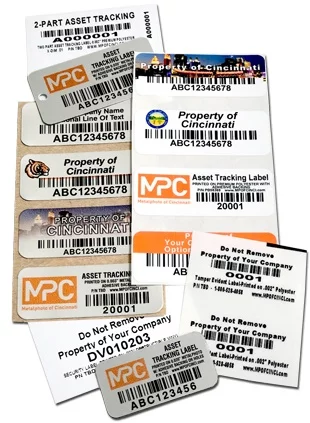
Asset tags serve as the foundation for an asset tracking process, enabling organizations to monitor equipment usage, plan regular maintenance and repairs, maintain compliance, streamline reporting and ordering, and optimize overall operations. The information below will help you determine which types of asset labels are best suited for your applications and the most important considerations to weigh when choosing asset tags and labels.
Determine the Types of Assets You Need to Track
The first step in determining which types of asset tags to consider is identifying the assets that your organization should be tracking. Assets fall into two primary categories: Fixed assets and movable assets. Fixed assets include things like office furniture, machinery and equipment, signs (such as road signs or building signs), buildings, factories, and fixtures, HVAC equipment, and similar items. Moveable assets include things like audio-visual equipment, computers and other electronics, filing cabinets and storage cabinets, and the like.
Generally, you should track any assets that require ongoing maintenance and repair, all high-value assets that are depreciated, and assets that are shared between departments or locations. Some companies use asset tags to streamline inventory management, and others use asset tags to perform compliance audits, reduce loss, and for many other purposes.
There are several considerations that can help you select the right asset labels for your application. One consideration is the value of the assets. For tracking high-value, moveable assets, for instance, you might consider an asset label with security features that discourages tampering and theft.
Industry regulations can also come into play. Military applications, for example, have strict requirements for asset labels, and there are asset labels designed specifically to meet the unique needs of certain industries and applications, such as LDAR tags, warehouse labels, and labels and tags designed for the utilities industry.
Some asset labels are durable enough to withstand harsh conditions or outdoor elements, so it’s important to consider the environmental conditions in which they’ll be used and select labels made of materials suitable for the environment:
Polyester, Polycarbonate, or Vinyl
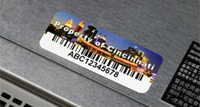
For indoor use such as general office use, asset tags are commonly printed on polyester, polycarbonate, or vinyl. A clear polyester film overlay adds greater protection and enables asset tags to resist exposure to things like oil and water, general purpose cleaners, and mild acids.
Metalphoto® Anodized Aluminum
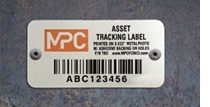
For applications requiring greater durability, such as manufacturing or chemical processing environments, Metalphoto® anodized aluminum is the material of choice. These labels are created with a unique manufacturing process, where the label’s image is below the surface for superior resistance to extreme heat and cold, UV, and chemicals and solvents, as well as abrasion. While these materials offer superior durability, they can be used for many different applications from laptops to machinery, and they’re suitable for both indoor and outdoor use.
Learn More About Metalphoto’s Durability Characteristics
Types of Asset Tags for Common Applications
Because asset tags are used in a variety of applications, asset tags are not a one-size-fits-all purchase. To accommodate various use cases, there are a multitude of asset tag types and designs that are suitable for different purposes. Below is a list of the most common applications for asset labels, including the primary types of asset tags suitable for each purpose.
Durable Asset Tags for Indoor and Outdoor Use

Durable foil asset labels are an ideal choice for many general use applications where assets may be exposed to outdoor elements, chemicals, abrasion, or solvents. For applications requiring top-notch durability, rigid aluminum asset tags are often a good choice. Rigid aluminum asset tags are often used in the manufacturing, telecoms, and cable industries, as well as in healthcare, industrial, and chemical processing applications.
Durable Asset Tags for Indoor Use
If you’re looking for durable asset labels for indoor use, premium polyester asset labels are most often used for indoor applications without exposure to harsh chemicals and other environmental hazards. Look for labels that offer good resistance to general purpose cleaners, water, oil, and mild acids for better durability.
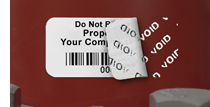
Designed for moveable assets that are prone to theft or loss, tamper-evident asset tags help to prevent tampering and unauthorized transfer by leaving a clear “VOID” mark on both the label material and the mating surface when the label is removed. Another asset tag option that deters theft, tampering, and unauthorized transfer is the destructible vinyl asset tag, which breaks apart if someone attempts to remove the label from its surface. These labels are best suited for indoor use.
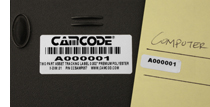
Do you have assets that require frequent re-ordering? This use case is common in the healthcare industry, where providers may use essential supplies in rushed situations and don’t have time to locate a bar code scanner to document the use of the asset. Two-part asset labels are the easy solution, allowing workers to simply pull the second label from the asset and adhere it to a patient chart or other documentation. For inventory-based assets, two-part asset tags streamline the process of re-ordering and record keeping.
Not every asset requires lifetime tracking. You may also have assets that must be tracked as they move through your company, but eventually exit the organization. It doesn’t make sense to invest in permanent asset tags that may not integrate with the tracking system for the company acquiring the asset after it leaves your premises, nor does it make sense to make the investment in durable, permanent asset tags for assets that will be maintained by your company for only a short time.
While by no means an exhaustive list, the types of asset tags described above represent the asset tags and labels designed for general purposes, and these different types of asset tags often find use cases spanning every industry.
Considering the type of asset, environmental conditions, durability requirements, and industry regulations will help you choose an asset label that’s up to the task. With the right asset tags, you’re better able to maintain optimal workloads and consistent preventative maintenance schedules so that you can extend the usable life span of your high-value assets.
Related information on our Blog: